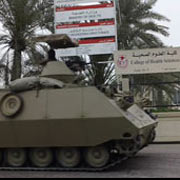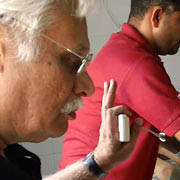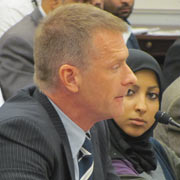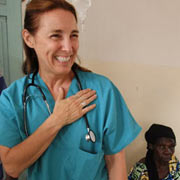PHR's online and print newsletter: Summer/Fall 2011 edition
Table of Contents:
Do No Harm: PHR's Report on Bahrain – page 1
Breaking Impunity: A Joint Medical–Legal Response to Rape Crisis – page 3
Spotlight: Dr. Coleen Kivlahan, PHR Asylum Network Volunteer, Mentor, Trainer – page 4
>> Read the newsletter in original print format (pdf)
Do No Harm
BAHRAIN:THIS SPRING THE WORLD TURNEDITS ATTENTION to the widening ripple of demonstrations across the MiddleEast, as citizens took to the streets to defend their rights.
In the Kingdom of Bahrain,a demonstration in Pearl Square became a flashpoint for unrest. Beginning onFebruary 14, 2011, protesters gathered there to call for a new constitution,greater political freedom, and an end to discrimination by the Sunni rulingelite against the majority Shi’a population.
A swiftgovernment crackdown was launched wherever protests erupted. Civilianprotesters were fired upon without warning. Even as they attempted to flee,they were shot at close range with live ammunition, birdshot, and rubberbullets and sprayed with tear gas and unidentified chemical agents.
What happened next unfolded outside of international attentionor media glare. The Government of Bahrain systematically turned its medicalfacilities into instruments of repression and retaliation. Patients wereabused and physicians were targeted in what Richard Sollom, Deputy Director ofPhysicians for Human Rights, and chief investigator for the report calls,“possibly one of the worst government attacks on a medical community in thelast 50 years.”
Emergency Investigation
Following the February protests, thecapital’s highly respected 821-bed Salmaniya Medical Complex was overwhelmedwith more than 700 emergency cases. Protesters brought to the emergency roomwere beaten and arrested by security forces. Their wounds marked them forretaliation.
On March 15,Bahrain’s military forces seized Salmaniya Medical Complex, placed armed guardson each floor, and positioned tanks at the entrance. Some doctors abandoned thewhite coats they once wore with pride for fear of reprisal.
As the alarmingreports escalated, PHR staff began planning an emergency investigative trip toBahrain. They quickly established methodology and logistics for the trip, drawnfrom PHR’s 25 years of experience investigating abuses of medical neutrality.Dr. Nizam Peerwani, a forensic pathologist and chief medical examiner withprior service as a volunteer medical advisor on PHR missions, joined RichardSollom on the trip. His experience and fluency in Arabic were crucial to theinvestigation’s success.
When the teamleft on April 2, they were not sure if they would be barred upon arrival at theBahrain airport. They managed to gain entry and during the next week conducted47 anonymous interviews with medical staff and eyewitnesses to abuse. Theyreviewed medical records (when available), examined victims to corroboratetheir stories, and secured independent verification for each incident.
Safety of theBahraini interviewees was paramount. The PHR team switched cars, changedlocations and met victims in private homes, or wherever they felt most comfortable.A public stroll in a crowded shopping mall was sometimes the best cover.

At a localhealth clinic, the team met with a physician in a private room. In hushedtones she explained that young men wounded in protests were not coming to herclinic for treatment, for fear of arrest and imprisonment. “As a physicianthis was shocking to me,” said Dr. Peerwani. “We are accustomed to treatingpatients in need, speaking freely, and sharing medical records and opinions.This physician was not able to do any of these things. She was clearly veryfrightened.”
Dr. Peerwani’s cultural fluency enabledthe team to closely interact with two families whose loved ones had died undersuspicious circumstances. One family presented photos detailing extensiveinjuries to the body of a man who had since been buried. The second familyinvited the team to inspect a man’s body at an Islamic funerary where it wasbeing prepared for burial. “Families were desperate to learn the truth aboutwhat had happened. We shared what we could from the evidence. It was dangerousfor these families to speak with us, and I worry about the risk they took. ButI think their need to know simply overcame their fear. We are honored to be avoice for them and tell the world what we learned in Bahrain,” said Dr.Peerwani.
On their visit toSalmaniya Medical Complex on April 8, masked security guards confronted the PHRteam, demanding to know the purpose of their visit, and later escorted themfrom the facility. The research team left the country without incident thatnight and returned with the first forensic evidence of the human rights abusesunfolding in Bahrain.
page 2
Report Findings
Excessive ForceAgainst Unarmed Persons
February 14—Rubber bullets fired at close range fractured a25-year-old’s jaw and blasted his eye from the socket. The eye was surgicallyremoved, but the patient refused to return to Salmaniya Medical Complex forfollow-up treatment. He feared the security forces stationed there. Thephysician who treated this patient was later detained.
March 15—A 17-year-oldprotester carrying a flower to symbolize non-violence was fired upon withoutwarning. Shotgun pellets blinded his right eye. Armed men entered the hospitalroom he shared with three other wounded protesters. They each were beaten withfists and batons, and an “X” was marked on the door. The abuse was repeatedeach night. Upon release from the hospital, the youth refused to return forurgent postoperative care.

Hospital Hijacked forPolitical and Military Retribution
March 16—Security forces pulled a dozen youngmen from their hospital beds. Dragged through the hallway, leaving trails ofblood, they lay on the floor for four hours before being transferred to Ward62 on the 6th floor. This room became a torture center, where false confessionswere coerced and videotaped.
April 2—Four armed security officers began a nightof terror by cursing and bludgeoning three on-call physicians, accusing them ofbeing “traitor doctors.”
Physicians Abducted and Disappeared
Transplant surgeon, endocrinologist, pediatric orthopedic surgeon,obstetrician, dentist, ophthalmologist. Not only does this list attest to theworld-class level of medical care delivered in Bahrain, but physicians fromthese disciplines joined the ranks of nurses, paramedics, and ambulance driverswho were detained or disappeared. At least 70 medical personnel were arrestedor abducted:
March17—Security forces abducted a pediatric surgeon from the operating room whilehe was performing surgery.
April 1—At 4 a.m., police and masked men tore arheumatologist from his home as his family watched in terror.
April 4—A pediatrician was ordered to report tothe Ministry of Interior at 8:00 p.m. She was held overnight but her familyheard nothing more about her whereabouts.
Why Attack Medical Professionals?
According toSollom:
Because doctorsare trained to apply their skills without discrimination, they glean first-handknowledge of types of injury and numbers of deaths during a conflict. Andimportantly, they can discern the cause of injury and death. That expertiseand knowledge make doctors important witnesses to government abuses and, in thecase of Bahrain, make them targets themselves.
In response tothe PHR investigation, Bahraini officials made inflammatory accusations. In aBBC interview, the Minister of the Interior claimed that physicians performedunnecessary surgeries or made small wounds larger to dramatize the protesters’case. But according to Sollom, “All of our interviews dispute that claim andconclude that physicians acted impartially and in the best interest of theirpatients.”
Advocacy and Action
The news from the PHR report, DO NO HARM: A Call for Bahrain to End Systematic Attacks on Doctors and Patients, wasimmediately carried by the international media: front-page and follow-upcoverage in The New York Times, reports on CNN and the BBC, and pickup inevery global newswire.
Richard Sollombriefed elected officials in Washington and testified before the Tom LantosHuman Rights Commission of the US Congress. He also met with the BahrainiAmbassador to the United States and with the Bahraini Foreign Minister.

Through professional associations, theinternational medical community condemned the actions of the Government ofBahrain. The American Medical Association issued a model letter based on PHR’s call for action and delivered 815 member letters to the Bahraini consulate,demanding the unconditional release of the doctors.
Incredibly, morethan 40 physicians have been singled out for criminal prosecution. “This breachof medical neutrality will have an incalculable effect on the people ofBahrain,” said Richard Sollom. “There is no ‘undo’ button to reset trust in themedical system. In addition, every medical professional detained or arrested isnot serving patients. The healthcare system of Bahrain, once a shining model inthe Arab world, has been seriously undermined.”
Medical Neutrality
Doctorshave an ethical duty to prevent illness and care for the sick and wounded withoutregard to politics, race, or religion. Society in turn has an obligation toprotect physicians’ independence as they impartially heal the sick and treatthe injured.
The ethics ofmedical practice date back as far as the Hippocratic oath, and include moderntreaties covering medical delivery in times of war and armed conflict.
PHR is an authorityon abuses of Medical Neutrality, and since 1987 has investigated cases in:Panama, Chile, El Salvador, Iraqi-occupied Kuwait, Thailand, Kashmir, theformer Yugoslavia, Somalia, Russia, Iraq, Nepal, Zimbabwe, Saudi Arabia, Libya,Bahrain, and the United States.
page 3
Breaking Impunity: AJoint Medical–Legal Response to Rape Crisis
MASS RAPE IS A CRUEL COMPANION TO WAR AND CONFLICT. In the 1990s,Physicians for Human Rights investigated its horrific effects in the formerYugoslavia, documenting how rape was used as a tool of “ethnic cleansing
Two decadeslater, across Central and East Africa, tens of thousands of women and girlshave been, and continue to be sexually assaulted by government troops, rebelforces, and civilians.
After conductinga field assessment in January 2011, PHR is raising funds for an innovativeprogram to combat mass sexual violence by forming a network of local medicaland legal professionals. It will focus on the African countries indictedfor rape crimes by the International Criminal Court.
The PHR program will launch in Kenya and the Democratic Republicof the Congo (DRC), eventually including the Central African Republic (CAR) andSudan.
Rape as a Weapon of War
Rape is no longer considered only a by-productof war but a tactic deployed against innocent civilians as part of anintentional strategy to humiliate the enemy, destroy communities, and inflictterror on whole populations.
In addition tothe initial physical and psychological trauma, rape survivors are often shamed,derided for speaking out, shunned, rejected by their families and even banishedfrom their communities, along with children they bear as a result of theattack.
It is a soberingreality that sexual violence spikes during armed conflict and flourishes in itsaftermath. Soldiers who raped as warriors may perpetuate sexual assaults intheir own communities. The act of rape then becomes local and “normalized.”
The Moment for Change
The past year has brought increased media coverage and new leadership to help solve the rapecrisis:

- UNWomen (led by Michelle Bachelet, physician and first female president of Chile)is a new force combating gender violence.
- MargotWallström, the UN’s Special Representative on Sexual Violence in Conflict,declares the highest priority is the elimination of impunity for rapeperpetrators.
- Internationalleaders recognize sexual violence is a de-stabilizing force that threatensglobal security.
- USSecretary of State Hillary Clinton urges punishment for mass rape at thehighest levels of accountability.
The International Criminal Court (ICC)is prosecuting rape as a war crime, or crime against humanity, in the DRC,Kenya, CAR, Uganda and Sudan. The charges in Sudan also include an additionalcharge of rape as genocide. These trials target the chief architects andleaders of mass rape campaigns.
Because the DRC, Kenya, CAR and Ugandaare all signatories to the 1998 Rome Statute that established the ICC, thesefour countries are also legally bound to prosecute rape at the local level.This brings new urgency for local action.
According toDeputy Director Susannah Sirkin, who heads PHR’s work on gender-based violence:
For the firsttime, public awareness, judicial reform and political will are all aligned toaddress the crime of rape in war. The major players in the internationalcommunity now have a stake in seeking justice. Even governments that stood byin the past feel scrutinized and, for the moment, wish to be seen as doingsomething.
With thisgroundswell, PHR has the opportunity to help local physicians, lawyers,judges, police and NGO leaders curb rape through the formation of a networkthat trains and connects these “first responders.”
Joint Medical and Legal Training
Local doctorsand nurses often need training in the collection of medical evidence, and arediscouraged by not having “high tech” devices or DNA testing at their clinics.But a careful exam recorded in a standardized rape kit can provide powerfulforensic evidence.
Joint trainingwould be helpful because most medical reports do not help attorneys. PersonallyI have not known ONE case helped by a medical report. ~ Attorney, Goma,DRC
Medical staffwill learn to prepare court-admissible documents, legal staff will learn theeffective use of medical evidence, and judges will expand their understandingof what constitutes forensic evidence. Physicians will prepare beforetestifying in court, so that they are not humiliated by the challenges andquestions of opposing attorneys.
The doctors areasked to answer legal questions, not medical ones. Lawyers want “yes” or “no”answers to simple questions. Often we do not have these answers. ~ HospitalOfficial, South Kivu, DRC
Law Enforcement
Police are oftena weak link in justice for victims. Officers may perpetrate rape, or acceptbribes in exchange for dropping charges. Districts with specially trainedofficers assigned to a “Gender Desk” may not even deploy them properly.However, some police in leadership posts value joint training:
Ideally, police, clinicians and attorneys would get the samekind of training. Then we would work together. ~ Police Chief,Goma, DRC
An End to Impunity
To break thecycle of violence and impunity, communities must witness a complete system:women empowered to report rape, medical personnel providing appropriate careand collecting the necessary evi;dence, prosecutors proving their cases, andperpetrators tried and punished for their crimes.
The medical-legalnetwork can do more than gain justice for individuals. It has the potential toempower communities, building a culture of courage and a refusal to acceptbrutality against women. ~ Susannah Sirkin
page 4
Spotlight: Dr. Coleen Kivlahan

DR. KIVLAHAN’S STORY IS A LESSONIN LISTENING VERY CLOSELY when children answer the question, “What do you want to be when you grow up?”
When she was inthe third grade, Dr. Kivlahan read a book written by an American doctor workingin Southeast Asia. She wrote to Dr. Tom Dooley volunteering to join him at hismedical mission in Laos. Not needing the services of an eight-year-old AlbertSchweitzer, the doctor suggested she study hard if she wanted to be aphysician and serve overseas.
She took hisadvice, eventually attending Dr. Dooley’s alma mater, St. Louis University. Dr.Kivlahan then set her own course, building a multi-dimensional medical careerthat continuously weaves together healing, health policy and human rights.
The daughter ofa roofer and a secretary whose family of six children did not have healthinsurance, she has continually put service to the needy at the forefront of herwork.
After completing her family medicineresidency in 1983, Dr. Kivlahan and her four-year-old son went to live andwork in a village of 800 people in Sierra Leone. She tackled rebuilding thevillage medical clinic and calculating the expansion needs of the overflowingcemetery. The richness of her experience in Africa led her to add an MPH toher MD. She then founded a family practice and an urban health clinic,treating uninsured patients. She formerly served as Missouri’s Director ofPublic Health and is currently an executive in a major health insurer's Medicaid division. She stillworks one day a week in a clinic for low-income people.
For adozen years, Dr. Kivlahan specialized in the treatment of young sexual-abuse victims. Children are often too traumatized to create a narrative suitable for criminal prosecution. Torture victims likewise have difficulty speaking about their experiences, and reuire medical documentatin to gain poi.tical asylum. The Chicago-based Marjori Kovler Center originally recruited Coleen to work with torture survivors.
She is now a member of PHR’s Asylum Network, helping to train its network of 450 medical professionals. “Dr.Kivlahan is one of the key volunteers who elevate PHR’s asylum work.Her imprint is onevery aspect of our program,” said Christy Fujio, Asylum Program Director. “Sheserves asylum seekers directly, trains other professionals, mentors them, and shares her insights so that we can develop the program in meaningful ways. She inspires us.”
Dr. Kivlahan honors the “secret stories” carried by asylum seekers. “We assume that the economic 'American Dream' is the great driver of immigration,” she said. “But we don't know that the Somalian working in the parking lot escaped torture, that the woman at our neighborhood bakery fled a forced marriage in Pakistan, or that the airport custodian traded a comfortable professional life for freedom of religion. Ifwe knew thecourage it took to leave their families,careers, and homeland behind, we would begin to understand what asylum seekers lose and gain.”
Dr. Kivlahanwas recently a key investigator for PHR’s field assessmentof mass rape in Central and East Africa, and is an ongoing advisor to the medical-legal network forming to fight the epidemic (see page 3, above).
“There are so many ways to get involved with PHR's work,” she urges. “In addition to working with survivors, physicians can provide financial support, act as advocates, mentor students, and particpate in the Asylum Network.” She emphasizes that treatingvictims of torture is an isolating experience that can take a toll. “It's not something you talk about at cocktail parties. PHR creates an important network of clinicians for mutual support and scientific advancement.”

